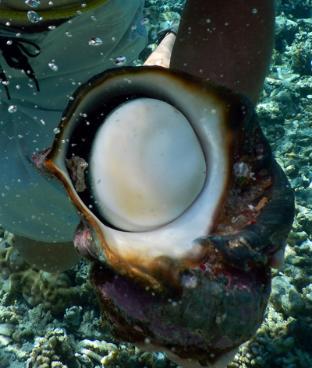Published in the Ocean Watch column, Honolulu Star-Advertiser © Susan Scott
December 30, 2013
Also known as cat’s eyes, opercula are calcium carbonate disks connected to the snail’s muscular foot. When disturbed, the snail withdraws its foot into its shell home and slams the door behind it.
 A great green turban snail operculum closes tight on a Tahiti reef.
A great green turban snail operculum closes tight on a Tahiti reef.
©2013 Susan Scott
Octopuses, crabs and other predators get around this lockdown by crushing or poking holes in the snail’s shell to get at the soft animal inside. Once the snail is eaten, its buttonlike operculum falls to the ocean floor, where it either remains or washes ashore.
In the Sea of Cortez (Gulf of California), I once came across a little island that had so many nickel- and quarter-sized turban snail operculums on its beaches that I went back several times to collect them for use in art pieces. Craig and I called the islet Operculi Island, figuring that must be the plural of the Latin word operculum, which means lid. Wrong guess. The correct plurals of operculum are opercula and operculums.
In the summertime on Oahu’s North Shore beaches, I often find dime-size or smaller operculums. And last week, while watching the big surf at Sunset Beach, I found countless even smaller opercula gleaming in the sand like tiny pearl earrings.
Imagine my shock and delight then, when during a snorkeling expedition off Tahiti last fall, I found an operculum the size of a fast-food cookie. Moments later, I discovered its maker, a snail so heavy it took two hands to pick up.
The snail is the great green turban, or Turbo marmoratus, a nocturnal algae-grazer native to the Indian and Western Pacific Ocean — but not to Tahiti. Since the flesh is good to eat, and artisans value the 4-pound, 9-inch-long shells as inlay material for furniture and jewelry, the species was introduced to Tahitian waters in 1967. Today, because of overcollecting, the green turban snail is endangered in India and depleted in Tahiti.
Days after my exciting discovery in the shallows of a remote island off Tahiti, I found several sand-filled green turban shells, and, scattered nearby, their algae-covered operculums. Someone had apparently enjoyed a snail meal, and in my view left the best behind.
The two giant shells that Craig helped me collect, clean and fly home, now decorate our lanai, and their hefty operculums anchor phone-charge cords to my desk and bedside stand.
I consider my turban treasures my best presents of 2013. When it comes to gifts from the sea, Christmas is a year-round affair.